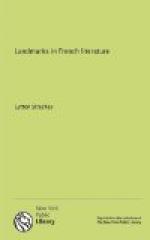The age produced one other poet who, however, by the spirit of his work, belongs rather to the succeeding epoch than to his own. This was BAUDELAIRE, whose small volume—Les Fleurs du Mal—gives him a unique place among the masters of the poetic art. In his form, indeed, he is closely related to his contemporaries. His writing has all the care, the balance, the conscientious polish of the Parnassiens; it is in his matter that he differs from them completely. He was not interested in classical imaginations and impersonal descriptions; he was concerned almost entirely with the modern life of Paris and the actual experiences of a disillusioned soul. As intensely personal as the Parnassiens were detached, he poured into his verse all the gloom of his own character, all the bitterness of his own philosophy, all the agony of his own despair. Some poets—such as Keats and Chenier—in spite of the misfortunes of their lives, seem to distil nothing but happiness and the purest beauty into their poetry; they only come to their true selves amid the sunlight and the flowers. Other writers—such as Swift and Tacitus—rule supreme over the kingdom of darkness and horror, and their finest pages are written in the Valley of the Shadow of Death. Writers of this kind are very rarely poets; and it is Baudelaire’s great distinction that he was able to combine the hideous and devastating conceptions of complete pessimism with the passion, the imagination, and the formal beauty that only live in magnificent verse. He is the Swift of poetry. His vision is black and terrible. Some of his descriptions are even more disgusting than those of Swift, and most of his pages are no fit reading for the young and ignorant. But the wise reader will find in this lurid poetry elements of profundity and power which are rare indeed. Above all, he will find in it a quality not common in French poetry—a passionate imagination which clothes the thought with splendour, and lifts the strange words of this unhappy mortal into the deathless regions of the sublime.
CONCLUSION
With the death of Flaubert in 1880, French literature entered upon a new phase—a phase which, in its essential qualities, has lasted till to-day, and which forms a suitable point for the conclusion of the present sketch.
This last phase has been dominated by two men of genius. In prose, MAUPASSANT carried on the work of Flaubert with a sharper manner and more vivid style, though with a narrower range. He abandoned the exotic and the historical visions of his predecessor, and devoted himself entirely, in his brilliant novels and yet more brilliant short stories, to an almost fiendishly realistic treatment of modern life. A precisely contrary tendency marks the poetry of VERLAINE. While Maupassant completely disengaged prose from every alien element of poetry and imagination, pushing it as far as it could go in the direction of incisive realism, Verlaine and his fellow-workers in verse attempted to make poetry more truly poetical than it had ever been before, to introduce into it the vagueness and dreaminess of individual moods and spiritual fluctuations, to turn it away from definite fact and bring it near to music.




